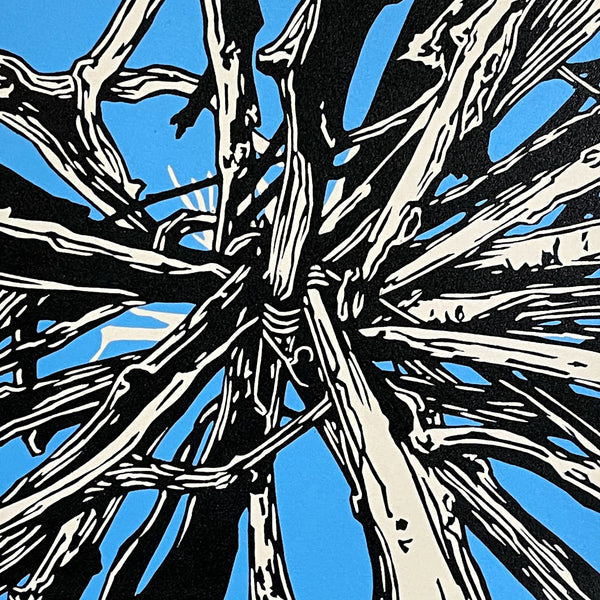Process
Woodcut
The simplest woodcut is a single layer print (usually black ink on white paper), where a flat block of wood is carved, creating a relief image in the wood. The remaining raised areas of the block are then inked with a brayer and printed onto paper.

Color-Reduction Woodcut
Color-reduction woodcut is a traditional and much more complicated form of printmaking which allows the artist to create editionable multi-colored prints. With this method, a single block is carved and printed successively resulting in an edition of identical prints. The quantity of prints in the edition is usually rather small and is permanently limited by the sequential destruction of the block. This is the medium I utilize most often in my work.
VIDEO: Deconstructing a Reduction Woodcut
To start, a detailed drawing is created on a woodblock. This design and planning process is vital, but often gets overlooked by viewers. It can take many days to plan, design and draw out the imagery on a block, however, all of this work is eventually destroyed by subsequent carving and printing actions. After I am happy with the drawing, I carve away areas of the woodblock that I have planned to stay white (or the color of the paper). I then use a brayer or roller to ink the surface of the woodblock with the lightest color found in the image and print that on several sheets of paper. I start with as many sheets as I need to complete the planned size of my edition along with a few extra to account for color tests and screw-ups. From this point on, the edition size is finite. There can never be any more pieces in the edition than the number of sheets I initially print.
For the next stage – using the same woodblock I just carved and printed – I carve away additional areas that I would like to remain the color I just printed. The block is then inked with the next color (generally working from light to dark) and carefully lined up over the previous impression to print the second layer. It is very important to accurately register the woodblock with the previous impression. This process of carving, registering and printing is then repeated for each color contained in my original design. In the end, the imagery on the block is reduced away through carving so that the only part left when the print is complete is the area used to print the final layer (usually black).

Collagraph
Collagraph is a somewhat uncommon form of printmaking. As its name might suggest, it involves the creation of a textural collage on a printing plate. Elements used to create the collage are limited only to materials that can be safely run through an etching press without damaging the paper or the press itself. Common materials include plant fibers, paper, fabric, string, sand and gesso. Once the collage is complete, ink is rubbed into the crevices and the plate is run through an etching press under printing paper and wool felts. The felts push the paper down into the crevices, grabbing the ink and the texture. The end result is an inked embossing.
While I rarely use this printmaking method on its own, I often print collagraphs in conjunction with the layers of color-reduction woodcuts to add textural elements and a more organic feel to the graphic, hard-lined shapes of the relief print.

